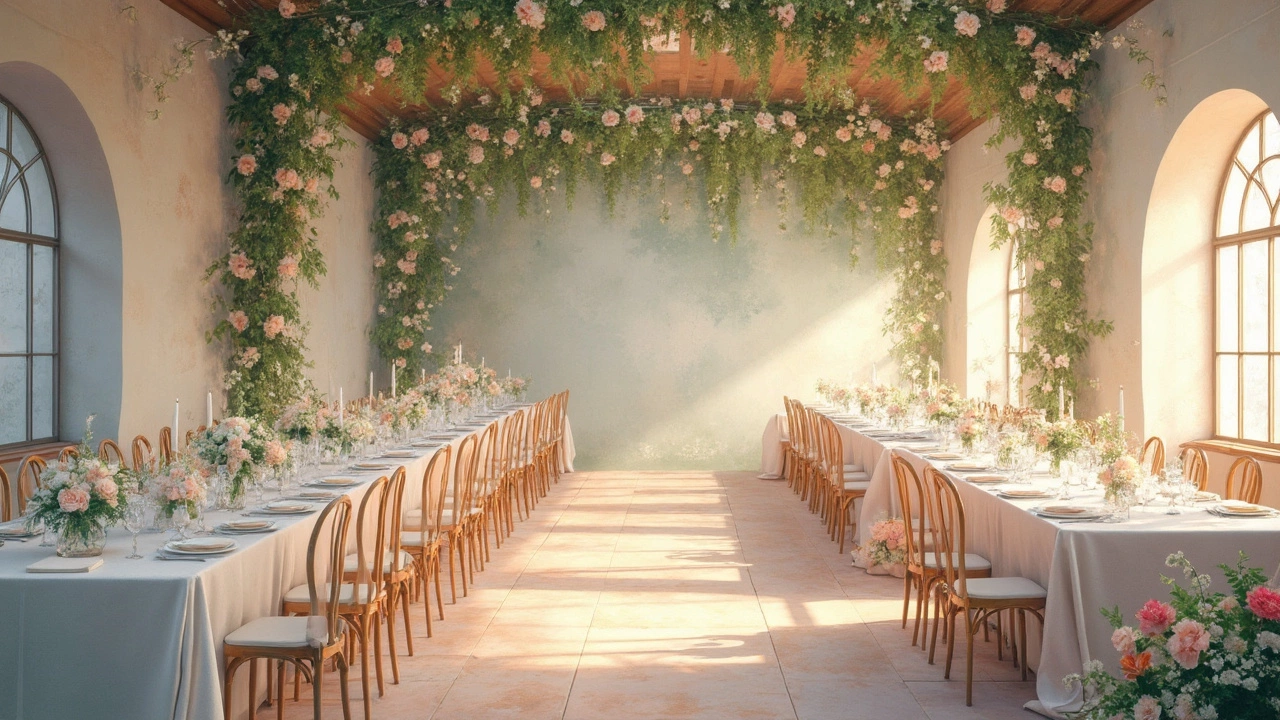If you’re staring at your first wedding decor job and thinking, “How do I even figure out what to charge?”—you are not alone. Setting your prices isn't just about picking a random number. There’s a method to the madness, and trust me, over- or undercharging can totally change how fun (or stressful!) this business feels.
Start by adding up every cost—materials, tools, rentals, travel, even that Starbucks you grab on the way. Forgetting just one little thing can chip away at your profit. Then, think about your time: planning calls, shopping, hauling boxes, setup, teardown… every hour should count. When I handled Calista’s best friend’s wedding last fall, I was shocked how much extra time got eaten up with unexpected setup tweaks and last-minute errands. Build a little padding for that ‘oops’ factor.
- Factors That Affect Wedding Decorating Prices
- How to Calculate Costs and Profit
- Different Pricing Methods Explained
- Pro Tips for Clear and Fair Wedding Decor Fees
Factors That Affect Wedding Decorating Prices
When it comes to how much to charge for wedding decorating, you need to look at a lot more than just how much tulle and fairy lights you need. There are plenty of things that can drive your prices up or down, and knowing them helps you avoid pricing yourself out of the local scene—or working way too hard for not enough.
- Venue size: The bigger the space, the more stuff you need, the more hours you’ll put in, and usually the higher the price. A ballroom for 200 is a whole other universe compared to a backyard wedding for 30.
- Theme and complexity: Simple table runners and a few centerpieces are one thing. Custom arches, installed backdrops, or creative lighting need extra time and skill. Those Pinterest-worthy weddings that take days to set up? Definitely higher up the pricing ladder.
- Materials and rentals: Silk or real flowers? Thrifted vases or brand-new gold ones? Some clients want it simple, but others expect everything to look like it came out of a bridal magazine (and that costs more!). Rentals for things like draping, chairs, or props also add up quickly.
- Labor: If you need to bring in a team to help, their wages should be included. Even your own time for hauling stuff, setting up, and tearing down is a real cost that shouldn’t be ignored.
- Season and demand: Summer Saturdays book up first and tend to cost more. Off-season or weekdays? You might need to offer a bit of a deal.
- Location and logistics: A venue in the city center with easy access is a breeze. A remote barn with no elevators, tricky loading areas, or long-distance hauling? Charge for those extra headaches.
| Factor | Price Impact |
|---|---|
| Large venue (200+ guests) | +30% to 40% |
| Peak season (May-Sept) | +15% to 25% |
| Custom installations | Varies (but always extra!) |
| Off-peak dates | -10% to 20% |
Don’t forget: If you’re working with premium materials or bringing in outside help, those costs stack up fast. The last thing you want is to realize at the end that you’ve barely covered your own expenses. Always keep these wedding decor pricing factors on your checklist every time you send out a quote.
How to Calculate Costs and Profit
Nailing down your costs is the only way to make sure your wedding decor pricing actually covers everything, from ribbon to labor. Some decorators skip steps and end up working for free, or worse—paying out of pocket.
Start by writing out every single expense. Think about:
- Materials: Florals (real or faux), vases, fabrics, candles, ribbons, signage—anything you need to create the look.
- Rentals: Tables, chairs, specialty linens, lighting, backdrops. If you use your own inventory, factor in wear and tear.
- Labor: Your hours + any help (friends, family, or hired hands). Don’t undervalue your own time—track all the setup, breakdown, consultation, and drive time.
- Transportation: Van or truck rental, gas, tolls, or even parking fees at the venue.
- Permits/Insurance: Some venues require these; check ahead so you’re not hit with surprise expenses.
Once you have your totals, add everything up. This is your base cost. But base cost is not your price! Next, mark it up to get your profit. A lot of decorators use a markup between 30% to 50% on top of costs. Big city? Markups might run higher; smaller towns, a bit less. For example, if your total cost is $1,000 and you want a 40% profit:
| Total Costs | Markup (%) | Final Price |
|---|---|---|
| $1,000 | 40% | $1,400 |
Your markup should cover your expertise, the risk you’re taking, and the headache of last-minute changes (and trust me, there are always changes). Don’t forget about taxes! They’re different everywhere, so find out if your prices should include sales tax or if that’s added on top.
If the couple wants to tweak things three days out, charge for the add-ons. Clear communication up front saves you from awkward conversations later. It’s not just about what you spend—it’s about being paid for what you know and the magic you bring to the decorating a wedding process.

Different Pricing Methods Explained
There’s no one-size-fits-all answer when it comes to wedding decor pricing. People use a few main ways to calculate how much to charge for decorating a wedding, and each method has its pros and cons. Let’s run through the options so you can find what fits your business best.
- Flat Fee: You charge one set price for everything—planning, materials, setup, breakdown—the whole kit and caboodle. Clients like the simplicity, and it can save you headaches with lots of little add-ons. But watch out: if the wedding ends up bigger or more complicated than planned, your profit drops fast.
- Hourly Rate: This is just like a contractor or babysitter. You set an hourly price, track your time, and bill based on how long the job takes. This works when jobs vary a ton in size and detail. Just be up front with clients about what counts as billable time. Some decorators in 2024 charge anywhere from $35 to $150 per hour, depending on their market and experience.
- Cost-Plus Pricing: You add up every direct cost—think candles, vases, linens—and tack on a markup (often 30% to 50%) for your labor and profit. The markup covers the unseen stuff, like time on the phone with vendors or late-night centerpiece tweaks. This approach is super transparent. If the client wants to swap plastic for glass, you both see how it hits the budget.
- Package Pricing: This is popular because it creates easy choices for clients. You build bundles: simple, standard, deluxe. Each tier has set decor pieces and perks. This method makes sales smoother—people love picking packages—but you have to define exactly what’s included so there are no surprises or extra requests you didn’t plan for.
Here’s a quick look at the average price ranges decorators charged for weddings in the United States in late 2024. Your rates can be higher or lower based on your style, the local market, and the scale of the event:
| Pricing Method | Common Range (2024) |
|---|---|
| Flat Fee | $1,000 – $8,000 |
| Hourly Rate | $35 – $150/hr |
| Cost-Plus | Materials + 30–50% markup |
| Package | $1,500 – $10,000+ |
Don’t be afraid to use a mix if that works for you. For example, maybe you offer packages for most clients, but charge hourly for setup on really custom events. The key is to keep it simple, fair, and super clear in your contract. It’s better to spell everything out early than to haggle over pricing after the big day.
Pro Tips for Clear and Fair Wedding Decor Fees
Nailing down clear, fair wedding decor pricing might sound overwhelming, but it actually saves you from so many headaches later. Transparency is your best friend if you want happy clients and a strong reputation.
First up: always provide a detailed quote. Don’t just throw out one big number. Break it down so it’s crystal clear what’s included—think setup, teardown, rentals, styling, travel, and even those little extras, like candles or chair sashes. This prevents any confusion or awkward questions after the wedding is over.
- List every service and item separately, so clients see what they’re paying for.
- Spell out payment terms—when deposits are due, final payment timing, and refund rules.
- Be upfront about extra charges. If extra time on setup means overtime, clients should know before you get started.
- Set a minimum fee for small weddings. If you’re spending your whole Saturday decorating, it should still be worth your while.
Next, keep communication open. Email every step in writing, even if you discussed details in person or over the phone. This makes sure everyone’s on the same page and is super helpful if anything ever comes into question.
About 68% of wedding pros say clients are most upset by surprise charges, according to a 2023 event industry survey. This just proves how key transparency is—not just for trust, but also your sanity.
| Tip | Why It Matters |
|---|---|
| Itemized Invoices | Makes pricing transparent and easier to justify |
| Written Quotes | Protects both you and the client from miscommunication |
| Clear Policies | Prevents disputes about refunds, changes, or timing |
A top planner from The Knot advises,
“A clear contract helps you avoid drama. Write everything down, from what you’ll decorate to cleanup details and payment due dates.”
Clients respect when you’re upfront about your charge for wedding decorating. If you can show real value with your work, they’re way more likely to recommend you to their friends—and who doesn’t want more referrals?
